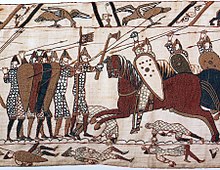The day of the battle that changed England forever!
Location! Location! Location!
This is a must if we are to ensure the survival of the Saxon nation!
Select a position which will give the Normans maximum aggravation!
On October 14th, the morning light illuminated the nature of the respective armies. Both were probably about 7,000 in terms of numerical strength. However apart from foot soldiers, the Normans had cavalry and many archers. The Saxons possessed neither, but their forces consisted of some 5,000 untrained and poorly armed peasants and perhaps 2,000 of the formidable, suicidal housecarls whose dedication to their king was beyond question.
Harold placed his men high on Senlac hill! It would be here that his army would fight and kill!
It would be here that Saxon England would do battle with the forces of Duke Will!

Senlac hill as it is today.
Harold would certainly not be the last property owner to decide on a birds eye view of the Sussex countryside when undertaking an important investment decision concerning essential resources. The Saxons had taken a position on a ridge which was flanked by marshes on either side and protected by thick woodland from the rear.
Why was this significant?
Harold knew that a vital element of the Norman attack would be by the cavalry! Men on horseback cannot charge effectively through dense forest which meant that he could not be attacked from the rear. The Normans would not be able to attack him from the left or the right because horses are unable to gallop through marshy ground! Harold was forcing William to attack him uphill through a relatively narrow channel. When the Normans reached the top of Senlac hill they would be confronted by the formidable Saxon ‘shield wall’.
Harold drew his forces close and near!
Knowing that William could not attack him from the rear!
The Saxon army was protected on either side!
As through marshy land the Norman horsemen could not ride!

Early on the morning of October 14th, hostilities commenced! The Normans launched assault after assault and their archers kept up a deadly barrage of arrows but still the Saxon shield wall on Senlac ridge remained firm.
The battlefield from the north as it would have looked from the Saxon lines.
Try as they might the Norman forces were unable to make a breach in the Saxon shield wall. The Normans were constantly being driven back by a continuous volley of missiles thrown from the Saxon ranks.

A scene from the Bayeux Tapestry showing Norman cavalry attacking the Saxon shield wall on Senlac ridge.
Things were not looking good for Duke William! Indeed the low point in the battle for the Normans was when a rumour spread that William had been killed. William quickly dispelled the rumour by lifting the face shield of his helmet and rallying his disheartened soldiers.

The scene from the Bayeux Tapestry showing William raising the face shield of his helmet.
Behind their shields, us, do the Saxons await!
To break their packed ranks, we need some ingenious bait!
We must think of something soon, before it is too late!
According to some accounts, the Normans then thought of an ingenious trick! They would attack, pretend to panic and flee down the hill in apparent disarray. The Normans hoped that the Saxons, seeing them in a state of fright, would break ranks and follow them down the hill thus creating a gap in the shield wall.
Our knights will feign fear, and run down the hill like frightened deer!
This will draw the Saxons away from the packed ridge and into the clear!
This is exactly what happened! At an opportune moment, the Normans whirled their horses around and surrounded the Saxons as they charged down the hill. At the same time, other Norman knights entered the gap in the shield wall made by the Saxons in their pursuit of the ‘terrified’ Normans! The shield wall was broken and this event rang the death knell, not only for many Saxons on Senlac hill, but also for Saxon England itself!


